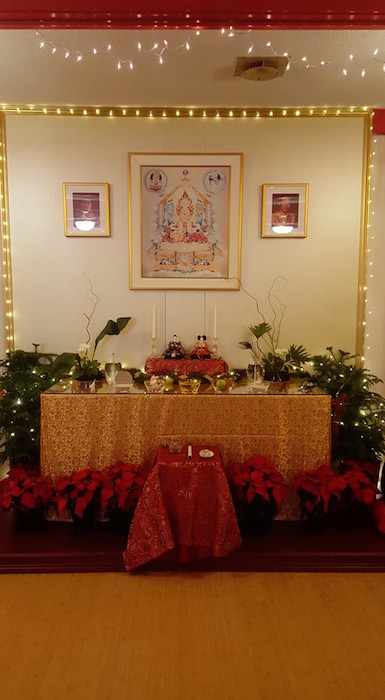Like most people trying to be conscious about habitual patterns I have mixed feelings about the holidays. And my ambivalence, like the holidays, seems to arrive earlier each year.
This year it was the day after Thanksgiving when I found myself in Home Depot amid gargantuan displays of stocking stuffers and holiday decorations.
“Stop! It’s all too soon, too fast and too much,” my mind cried out.
But the real irritation was that I had found myself humming along mindlessly to the store’s blaring holiday music. Something about reindeers.
But what’s the problem with men in red suits, reindeer and the spirit of love and generosity—with a little nostalgia mixed in?
The holiday season, it seems, now begins with Halloween and culminates with the crescendo of New Years, providing a slippery slope for all of us with memories, attachments and all things nostalgic. Whether they are memories or plans for the future—and are pleasant or haunting—we tend to spend more time in our mind someplace else and less time in the present moment. We operate on a kind of auto pilot while our mind is pre-occupied and distracted somewhere else as we go through the motions of our life. The auto pilot is a like a default mode we fall back on, relying on habitual patterns of thought and action that we’ve used over and over. At one point, they worked more or less, and sometimes they work now.
No harm in this really—it’s quite human. But the down side of spending less time in the present moment means that we have less accurate perception, thought and action. Less accuracy results in more mistakes. Unfortunately, world-wide throughout the holidays, hospital emergency room visits spike. Sadly, incidents of domestic abuse can increase as well.
There’s a folktale that is told in India about the eating habits of elephants. During the summer months when the fruit trees like papaya and mango are laden with sweet, ripe fruit, the elephants often gorge themselves, eating as much as they can. With their bellies full, the sugar of the fruit and the elephant’s body heat can begin a fermentation process creating alcohol and causing the elephants to become quite drunk. When this occurs you may witness a five-ton mammal crashing through the jungle at full speed.
Can this happen to us as human beings? Do we ever crash through our lives intoxicated by strong emotions that have nothing to do with the present moment? Definitely. This is how operating on auto pilot while under the influence—no matter whether chemical or emotional—can get us into trouble.
For people who are consciously working with habitual patterns—including compulsive behavior and addiction—what’s scary is acknowledging that you can be only one thought away from sobriety or inebriation. Recognizing the awesome power that your mind has to be present—or to become totally distracted—can be quite humbling.
And also liberating.
At Heart of Recovery meetings we investigate the intersection of recovery and meditation. Recovery, in this context, refers to freedom from behavior or thinking patterns which no longer serve us. In this way, meditation is used as a tool of inquiry to understand how our minds work.
The practice of meditation is based on gentleness. When we look at ourselves openly and honestly we can see that we have habitual patterns and acknowledge what happens when we think and act under their influence.
Making a relationship with our mind in this way we can begin to discern between what’s mindless and habitual and what in our experience is fresh, dynamic, vibrant, alive and real. We can begin to have some confidence in our ability to be present for our experience. Not only is this capacity always with us, it is an expression of our inherent nature—present way before the onset of learned behavior and habitual patterns.
From a contemplative point of view, meditation allows us to see both the familiar “itch” of habitual thoughts and behavior as well as our habitual response of scratching.
And this is where it gets really interesting.
A lot of us work with feelings of inadequacy and not feeling “good enough.” Whether it’s being a better friend, lover, parent, child, boss or teacher, there can be a large part of us that feels that we “should” be doing better. How we respond to this habitual “itch” of discomfort—by thinking negatively, eating, drinking, shopping, sex or drugs—is also how we perpetuate our pain. In meditation practice we can allow these dramas to play out without acting on them. When we do this it empowers us to choose if and how we respond.
Realizing that we don’t have to believe every drama our mind can dream up can provide a welcome sense of liberation. Sakyong Mipham, Rinpoche in Turning the Mind into an Ally notes, “Once we see how our mind works, we see how our life works, too. This changes us.”
How can this help us during the nostalgic excess and mass consumption of the holidays?
In the mid-1970s the Tibetan meditation master Chögyam Trungpa, Rinpoche began to introduce teachings about Shambhala which draws imagery and inspiration from the warrior culture of Tibet. Warriorship in this context places the highest value—not on aggression–but on personal bravery. Bravery, Trungpa emphasized, is not being afraid of who you are; it is being willing to be fully present for every moment of your life.
Warriorship in the Shambhala tradition emphasizes that the natural human traits of compassion, empathy, gentleness, wisdom and humor—all those qualities that make being a human being wonderful—are qualities that can only be experienced genuinely when we are being present for our life. From this perspective, thinking: “I’ll be braver and more confident and more generous sometime in the future when it’s more convenient,” is just wishful thinking. So too, wanting to live “more from the heart” is a nice aspiration for the future—but what about this present moment?
A bird cries, a motorcycle passes by, we notice the texture of the piece of paper that we are holding in our hand. Meditation in the Shambhala tradition is described as a path of gentleness that results in both taming the mind and also strengthening the mind’s natural ability to be present. As we continue, we begin to have more and more appreciation for what is fresh and real and alive and old patterns of thought and behavior have less and less appeal.
Being with other people who also want to be more present for their lives is the appeal and the gift of the sangha, or community of practitioners. The culture of Shambhala is based on the gentleness of meditation, the aspiration of bravery and the accuracy of nowness.
What does warriorship feel like?
Here’s an exercise you can try at home or in the office. Stand up. Raise your right leg up so that the right thigh is parallel with the ground. (It’s fine to use a chair to help with your balance . It’s also fine—if you like—to extend your arms at your sides for extra credit.)
Check in with your body. You may notice all of the dozens of micro-adjustments your body makes to remain in balance in the present moment. You may also feel the moment-to-moment “fine tuning” of your skeletal and nervous system—in each moment—as your weight shifts, muscles tighten and relax, ligaments, tendons and bones move.
Like the rest of our life, we can only balance fully by joining our mind and body in the present moment. As we maintain our balance we can see that thoughts of the future like, “This could be embarrassing if someone walks in now,” and thoughts of the past, “I remember the last time I lost my balance and fell on my face,” can be seen as unhelpful and ultimately irrelevant to our intention of remaining in balance in this present moment.
If we are to remain in balance we will have to let thoughts of the past and the future go on their way as we return our focus to the present. Now.
Hold this posture a little longer than is comfortable.
When the exercise feels complete, you can end by acknowledging your intention to be present. If you wish, you can acknowledge your own sense of warriorship.
~
Relephant links:
7 Tips for Beginning a Meditation Practice.
~
Author: Brett Ferrigan
Apprentice Editor: Adam Wilkinson Editor: Travis May
Images: Travis May







Read 1 comment and reply